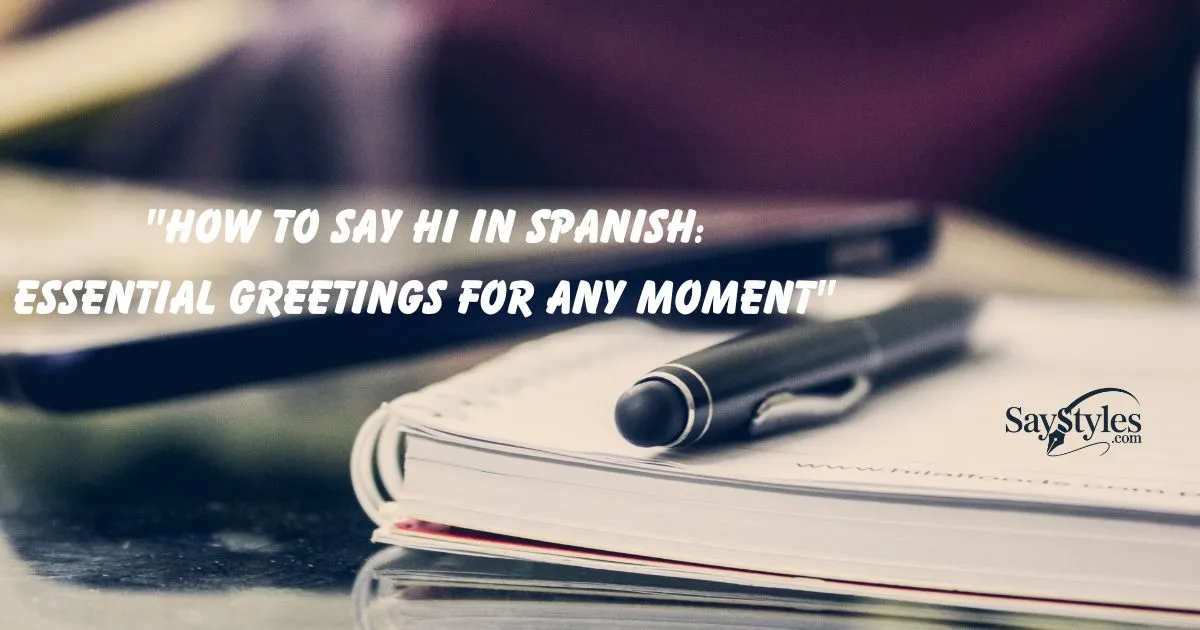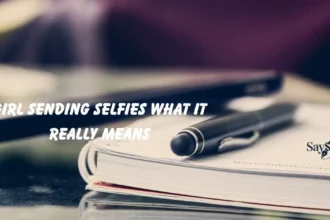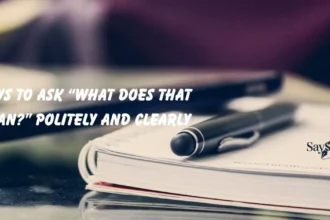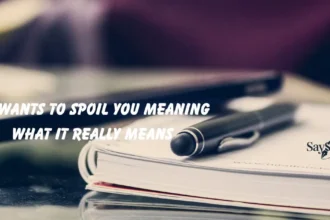“How to say hi in Spanish is often the first step to open any conversation.”
When I first started learning Spanish, the very first thing I wanted to know was how to greet someone. Saying hi in Spanish feels warm, friendly, and it quickly builds a connection. Simple words like hola can make you smile and bring two people closer, no matter where they are from.
We all know greetings are small, but they carry big meaning. They show respect, kindness, and sometimes even set the tone for the whole talk. If you use the right greeting, it can make someone feel welcome in just a second.
In this article, I’ll share different and essential greetings in Spanish that you can use anytime—whether it’s with friends, family, or even strangers. You’ll find easy examples that help you sound natural and confident while saying hi in Spanish.
What Saying “Hi” in Spanish Really Means
Saying “Hi” in Spanish is usually “Hola”, a simple and friendly greeting. It’s used in casual conversations, social media, or texting to say hello. Using it shows politeness and friendliness. In funny or playful responses, it can be paired with humor or emojis to make chats more lively.
List of Say Hi in Spanish Essential Greetings
• The Classic Greeting: Hola
• Casual Hellos with Amigos
• Friendly Morning Greetings
• Warm Afternoon Hellos
• Polite Evening Greetings
• Short and Sweet: Hi Variations
• Regional Slang for Hello
• Cool Ways Teens Say Hi
• Fun Greetings with Friends
• Formal Spanish Hellos
• Respectful Ways to Greet Elders
• Business-Friendly Greetings
• Travel-Friendly Hellos
• Everyday Street Greetings
• Playful Greetings for Kids
• Romantic Ways to Say Hi
• Flirty Spanish Greetings
• Funny Ways to Greet Someone
• Group Hellos in Spanish
• Texting and Online Greetings
• Emoji + Spanish Greeting Combos
• Fast Replies to Hola
• Saying Hi on the Phone
• Warm Welcomes for Guests
• Cultural Greetings by Country
• Differences Between Spain and Latin America
• Greetings with a Handshake
• Saying Hi with a Hug or Kiss
• Musical and Fun Hi Expressions
• Hi in Spanish for Social Media
• Greetings to Start a Conversation
• Slang Hellos You’ll Hear Often
• Cute Greetings for Couples
• Everyday Hi Phrases You Must Know
Simple Ways to Say Hi in Spanish
Story: Imagine Emma walks into a café in Madrid and meets Carlos for the first time. She wants an easy way to greet without overthinking.
When to Use: Perfect for beginners who just want a simple, friendly way to start a conversation.
When Not to Use: Don’t rely on this alone in formal settings like business meetings where more respect is needed.
Example:
Emma: “Hi!”
Carlos: “Hola!”
How to Respond 🗣️ Reply with a smile and repeat “Hola” or add “¿Cómo estás?” (How are you?).
The Classic Greeting: Hola
Story: Daniel is visiting Barcelona and every shopkeeper greets him with the classic word. He quickly realizes hola works everywhere.
When to Use: Use hola in almost any casual or polite situation.
When Not to Use: Avoid only if you’re answering the phone (use ¿Bueno? or Diga in some countries).
Example:
Daniel: “Hola, buenos días.”
Lucía: “Hola, ¿qué tal?”
How to Respond 🗣️ Say “Hola” back or add a polite “Mucho gusto” (Nice to meet you).
Casual Hellos with Amigos
Story: Sofia sees her friend Mateo on the street and instead of formal greetings, she uses a casual hello.
When to Use: Perfect for friends, classmates, or peers.
When Not to Use: Avoid in professional or formal environments.
Example:
Sofia: “¡Qué tal, amigo!”
Mateo: “Todo bien, y tú?”
How to Respond 🗣️ You can say “¡Todo bien!” or “¡Ey, qué onda!” if you’re in Latin America.
Friendly Morning Greetings
Story: Clara walks into her office in Mexico City and greets Diego with a cheerful good morning.
When to Use: Use Buenos días until around noon.
When Not to Use: Don’t use it in the afternoon or evening—it’ll sound odd.
Example:
Clara: “¡Buenos días, Diego!”
Diego: “¡Buenos días, Clara! ¿Lista para trabajar?”
How to Respond 🗣️ Answer with “¡Buenos días!” or add “Muy bien, gracias.”
Warm Afternoon Hellos
Story: Javier meets Ana at a café around 3 p.m. in Seville, and he greets her with the correct time-based phrase.
When to Use: From noon until around 7 p.m., say Buenas tardes.
When Not to Use: Don’t use it early in the morning or late at night.
Example:
Javier: “Buenas tardes, Ana.”
Ana: “Buenas tardes, Javier. ¿Cómo estás?”
How to Respond 🗣️ Repeat “Buenas tardes” or add a friendly “Muy bien, ¿y tú?”
Polite Evening Greetings
Story: At 9 p.m., Laura joins her neighbors for dinner in Madrid and greets them politely.
When to Use: Use Buenas noches when it’s dark outside or during nighttime gatherings.
When Not to Use: Avoid saying it too early in the afternoon.
Example:
Laura: “Buenas noches, don Pedro.”
Pedro: “Buenas noches, Laura. Bienvenida.”
How to Respond 🗣️ Reply warmly with “Buenas noches” or add “Encantado de verte.”
Short and Sweet: Hi Variations
Story: Diego meets Valeria at a street market in Mexico. Instead of long greetings, he uses a quick, easy version.
When to Use: Perfect for casual moments when you don’t want to sound too formal.
When Not to Use: Avoid in professional meetings or with elders where respect matters.
Example:
Diego: “¡Ey!”
Valeria: “¡Hola!”
How to Respond 🗣️ Say “Ey, ¿qué tal?” or simply reply “¡Hola!”.
Regional Slang for Hello
Story: In Buenos Aires, Camila greets Martín with “Che, qué hacés?”, while in Mexico her cousins use “¡Qué onda!”.
When to Use: Great for sounding local and blending in with native speakers.
When Not to Use: Don’t use slang in formal situations or business settings.
Example:
Camila: “¡Qué onda, Martín!”
Martín: “Todo bien, Cami, ¿y tú?”
How to Respond 🗣️ Reply with the same slang: “¡Qué onda!” or “Todo tranqui.”
Cool Ways Teens Say Hi
Story: At a school in Madrid, Lucas greets his classmates with quick phrases like “¡Ey, tío!” or “¡Qué pasa!”.
When to Use: Perfect for teens, young adults, or casual friendships.
When Not to Use: Avoid if you’re speaking to adults, teachers, or elders.
Example:
Lucas: “¡Qué pasa, Sofi!”
Sofia: “Nada, ¿y tú?”
How to Respond 🗣️ Say “Todo bien” or “Aquí ando.”
Fun Greetings with Friends
Story: Marisol runs into her best friend Julia at the park and greets her in a fun, energetic way.
When to Use: Best with close friends who enjoy lighthearted greetings.
When Not to Use: Don’t use it with strangers or in formal spaces.
Example:
Marisol: “¡Hola, loca! ¿Dónde estabas?”
Julia: “¡Aquí, te extrañé!”
How to Respond 🗣️ Reply with “¡Amiga!” or “¡Qué alegría verte!”.
Formal Spanish Hellos
Story: Alejandro walks into a business meeting in Bogotá and greets everyone politely with the right tone.
When to Use: Use formal greetings in professional, academic, or respectful environments.
When Not to Use: Avoid being too formal with close friends or kids—it may sound stiff.
Example:
Alejandro: “Muy buenos días, señores.”
Colleague: “Buenos días, señor Ramírez.”
How to Respond 🗣️ Say “Buenos días” back or add “Un placer verlo.”
Respectful Ways to Greet Elders
Story: Camilo greets his grandmother’s friend in Colombia, showing respect with a warm, polite phrase.
When to Use: Always when speaking to elders, authority figures, or people you don’t know well.
When Not to Use: Avoid using only slang or casual words with elders—it may seem disrespectful.
Example:
Camilo: “Buenas tardes, señora Rosa.”
Señora Rosa: “Buenas tardes, joven Camilo.”
How to Respond 🗣️ Reply with “Buenas tardes” or “Mucho gusto.”
See also: “WTW Meaning in Text: How to Respond and Use It Smoothly”
Business-Friendly Greetings
Story: Isabel attends a work conference in Mexico City. She introduces herself to a potential client using a polite greeting.
When to Use: Best in professional meetings, formal emails, or work events.
When Not to Use: Avoid with friends or casual hangouts where it may feel too stiff.
Example:
Isabel: “Muy buenos días, señor López. Un gusto conocerlo.”
Señor López: “Buenos días, señora Isabel. El gusto es mío.”
How to Respond 🗣️ Reply with “Buenos días” or “Un placer hablar con usted.”
Travel-Friendly Hellos
Story: Mark is traveling through Peru. At a small shop, he greets the shopkeeper with a polite yet simple phrase.
When to Use: Ideal when you’re abroad and need an easy, respectful way to say hi.
When Not to Use: Don’t rely only on slang—locals appreciate clear, standard greetings.
Example:
Mark: “Hola, buenos días.”
Shopkeeper: “Buenos días, caballero.”
How to Respond 🗣️ Say “Gracias” and add “¿Cómo está?” to sound polite.
Everyday Street Greetings
Story: In Madrid, Javier sees his neighbor walking the dog and greets him casually.
When to Use: Perfect for short encounters with neighbors, acquaintances, or strangers on the street.
When Not to Use: Avoid if the situation requires a professional or very formal introduction.
Example:
Javier: “Buenas, vecino.”
Neighbor: “Buenas, Javier.”
How to Respond 🗣️ Reply with “Buenas” or “Hola, ¿qué tal?”.
Playful Greetings for Kids
Story: Ana greets her little cousin Mateo in a fun way that makes him laugh.
When to Use: Perfect for kids or playful family moments.
When Not to Use: Avoid in professional or serious situations.
Example:
Ana: “¡Hola, campeón!”
Mateo: “¡Hola, Ana!”
How to Respond 🗣️ Say “¡Hola, princesa!” or “¡Hola, campeón!” depending on the child.
Romantic Ways to Say Hi
Story: Daniela meets her boyfriend Andrés for a date and greets him with a tender, affectionate phrase.
When to Use: Use these when greeting someone you’re dating or in a romantic mood.
When Not to Use: Avoid using them with strangers or in public professional spaces.
Example:
Daniela: “Hola, mi amor.”
Andrés: “Hola, preciosa.”
How to Respond 🗣️ Reply with “Hola, corazón” or “Te extrañé.”
Flirty Spanish Greetings
Story: Marcos sends Lucia a text at night with a playful, flirty hello to spark the conversation.
When to Use: Best in dating chats, flirty texts, or with someone you’re interested in romantically.
When Not to Use: Avoid if the relationship is strictly professional or not mutual.
Example:
Marcos: “Hola, guapa 😉.”
Lucia: “Hola, guapo. ¿Pensando en mí?”
How to Respond 🗣️ Say “Siempre pienso en ti” or “Claro, ¿y tú?”.
Funny Ways to Greet Someone
Story: Laura meets her friend Miguel at a café and uses a humorous greeting to make him laugh.
When to Use: Great for friends or casual settings when you want to break the ice with humor.
When Not to Use: Avoid with strangers, elders, or in professional environments.
Example:
Laura: “¡Hola, máquina de café ambulante!”
Miguel: “¡Jajaja, hola Laura, me ganaste con eso!”
How to Respond 🗣️ Reply with a playful comeback like “¿Quién necesita café cuando te veo?”
Group Hellos in Spanish
Story: Pablo walks into a party and greets a group of friends at once with an energetic hello.
When to Use: Use when entering a group of people or friends.
When Not to Use: Avoid if you don’t know the group well—it may feel too forward.
Example:
Pablo: “¡Hola, chicos! ¿Cómo están?”
Friends: “¡Hola, Pablo!”
How to Respond 🗣️ Reply with “¡Hola a todos!” or “¡Qué gusto verlos!”
Texting and Online Greetings
Story: Sofia texts her friend Javier “Hi” in Spanish using casual language for chat.
When to Use: Perfect for online messages, social media, or texting apps.
When Not to Use: Avoid using slang or overly casual greetings in professional chats.
Example:
Sofia: “¡Hola! ¿Qué tal?”
Javier: “¡Hola! Todo bien, ¿y tú?”
How to Respond 🗣️ Reply with “Todo bien, gracias” or “¡Hola! Qué alegría tu mensaje.”
See also: “Top Replies to Oldsmobile 442: Fun, Clever, and Witty Ideas
Emoji + Spanish Greeting Combos
Story: Marta sends a cheerful greeting with emojis to her friend Lucia.
When to Use: Use in texts or social media to make your greetings more fun and expressive.
When Not to Use: Avoid in formal or professional settings where emojis may seem unprofessional.
Example:
Marta: “¡Hola 😄☀️!”
Lucia: “¡Hola! 😎✨”
How to Respond 🗣️ Reply with emojis or add “¡Qué alegría verte online!”
Fast Replies to Hola
Story: Ricardo receives a quick “Hola” from his coworker and wants a fast but friendly response.
When to Use: Perfect for casual or busy conversations where speed matters.
When Not to Use: Avoid using overly short replies with someone you’re trying to impress.
Example:
Coworker: “Hola”
Ricardo: “¡Hola! ¿Cómo estás?”
How to Respond 🗣️ Reply quickly with “¡Hola!” or “¡Hey! ¿Qué tal?”
Saying Hi on the Phone
Story: Valeria answers a call from her friend Juan and wants to greet warmly over the phone.
When to Use: Best for calls with friends, family, or casual conversations.
When Not to Use: Avoid texting the greeting if you’re on a formal business call—it may feel informal.
Example:
Valeria: “¡Hola, Juan! ¿Qué tal?”
Juan: “¡Hola, Valeria! Todo bien.”
How to Respond 🗣️ Say “¡Hola!” enthusiastically or add “¡Qué gusto escucharte!”
Warm Welcomes for Guests
Story: Camila invites her friends over and greets them warmly at the door with a friendly Spanish hello.
When to Use: Ideal for hosting parties, dinners, or casual visits at home.
When Not to Use: Avoid in formal professional settings where a more polite greeting is needed.
Example:
Camila: “¡Hola, bienvenidos a casa!”
Friends: “¡Gracias, Camila! Qué lindo tu hogar.”
How to Respond 🗣️ Reply with “¡Gracias! Qué gusto estar aquí” or “¡Hola! Qué alegría verte.”
Cultural Greetings by Country
Story: Javier travels through Argentina, Mexico, and Spain, noticing different greeting customs in each country.
When to Use: Useful for travelers wanting to respect local customs while saying hi.
When Not to Use: Avoid using one country’s casual greeting in a formal or unfamiliar setting.
Example:
Javier in Argentina: “¡Che, hola!”
Friend: “¡Hola, che! ¿Cómo estás?”
How to Respond 🗣️ Repeat the greeting style or say “¡Todo bien, gracias!” to match local tone.
Differences Between Spain and Latin America
Story: Ana compares how people in Madrid greet with “¡Hola!” versus in Mexico City where they often say “¡Qué tal!”.
When to Use: Good for learners who want to sound authentic depending on the region.
When Not to Use: Avoid using slang from one region with elders or formal situations in another.
Example:
Madrid: “¡Hola! ¿Cómo estás?”
Mexico City: “¡Qué tal! ¿Cómo va todo?”
How to Respond 🗣️ Match the regional style: “¡Todo bien!” or “¡Muy bien, gracias!”
Greetings with a Handshake
Story: Daniel meets a new colleague in Bogotá and shakes hands while saying a polite hello.
When to Use: Best for formal introductions, business meetings, or professional events.
When Not to Use: Avoid in casual or intimate settings where a hug or kiss is more appropriate.
Example:
Daniel: “Mucho gusto, señor Gómez.”
Señor Gómez: “Encantado, Daniel.”
How to Respond 🗣️ Reply with “Mucho gusto” or “Un placer conocerlo” while shaking hands firmly.
Saying Hi with a Hug or Kiss
Story: Lucia greets her cousin in Spain with a quick hug and a kiss on the cheek while saying hello.
When to Use: Perfect among family or close friends where physical greetings are common.
When Not to Use: Avoid with strangers or in professional settings.
Example:
Lucia: “¡Hola, Carlos!” (gives a hug and a cheek kiss)
Carlos: “¡Hola, Lucia! Qué alegría verte.”
How to Respond 🗣️ Return the hug/kiss and say “¡Hola!” or “¡Qué gusto verte!”
See also: Other Ways to says “Not Only” Elevate Your Language
Musical and Fun Hi Expressions
Story: Sofia greets her friend Javier by singing a playful “¡Hola, hola!” tune while waving.
When to Use: Great for friends, parties, or playful moments to make greetings more fun.
When Not to Use: Avoid in formal or professional settings—it may seem childish.
Example:
Sofia: “¡Hola, hola, Javier!” 🎶
Javier: “¡Jajaja, hola Sofia!”
How to Respond 🗣️ Join in the fun by singing back or saying “¡Hola, hola, qué alegría verte!”
Hi in Spanish for Social Media
Story: Maria posts a story and comments “¡Hola, amigos!” to greet her followers.
When to Use: Perfect for Instagram, Facebook, WhatsApp, or TikTok posts and messages.
When Not to Use: Avoid overusing it in professional posts or business accounts.
Example:
Maria: “¡Hola, amigos! ¿Cómo están?”
Followers: “¡Hola, Maria!”
How to Respond 🗣️ Reply with “¡Hola!” or add “¡Qué gusto verte online!”
Greetings to Start a Conversation
Story: Leo wants to start chatting with his new classmate Elena and uses a polite hello.
When to Use: Best for opening casual or friendly conversations.
When Not to Use: Avoid saying just hi in serious discussions without context.
Example:
Leo: “¡Hola, Elena! ¿Cómo estás?”
Elena: “¡Hola, Leo! Bien, gracias. ¿Y tú?”
How to Respond 🗣️ Continue with “Muy bien, gracias” or ask a friendly question back.
Slang Hellos You’ll Hear Often
Story: In Mexico, Pablo greets his friends with “¡Qué onda!” while walking down the street.
When to Use: Perfect with peers, teens, or casual gatherings.
When Not to Use: Avoid with elders, teachers, or formal situations.
Example:
Pablo: “¡Qué onda, Sofi!”
Sofia: “¡Todo bien, Pablo!”
How to Respond 🗣️ Reply with the same slang: “¡Qué onda!” or “¡Todo tranqui!”
Cute Greetings for Couples
Story: Lucia greets her boyfriend Daniel with a sweet nickname while saying hi.
When to Use: Ideal for romantic relationships, texting, or in-person greetings.
When Not to Use: Avoid with people you’re not close to—it may feel too personal.
Example:
Lucia: “¡Hola, mi cielo!”
Daniel: “Hola, mi princesa.”
How to Respond 🗣️ Reply with “Hola, amor” or “¡Qué lindo verte!”
Everyday Hi Phrases You Must Know
Story: Marta learns common greetings like “Hola”, “Buenos días”, and “¿Qué tal?” to use daily in Spain.
When to Use: Perfect for everyday interactions with friends, neighbors, or coworkers.
When Not to Use: Avoid using informal phrases in very formal or official meetings.
Example:
Marta: “¡Hola! ¿Qué tal?”
Neighbor: “¡Hola! Todo bien, gracias.”
How to Respond 🗣️ Reply naturally with “Todo bien, ¿y tú?” or “¡Hola! Qué gusto verte.”
How These Clever Responses Actually Work
Funny responses using Hola work because they combine language and playfulness. They make messages friendly, relatable, and engaging. Adding a fun twist or emoji makes greetings more memorable and expressive. These replies are perfect for starting chats or keeping conversations lighthearted.
Top 15 Editor’s Choice Responses
- Hola – The classic, simple, and most universal greeting. Works anytime, anywhere.
- ¡Buenos días! – Perfect for morning greetings. Shows politeness and warmth.
- ¡Buenas tardes! – Ideal for afternoon encounters; respectful yet friendly.
- ¡Buenas noches! – Use this for evening or nighttime greetings.
- ¿Qué tal? – Casual way to ask “How’s it going?” among friends.
- ¿5 estás? – A friendly, slightly more personal “How are you?”
- ¡Qué gusto 55! – Expresses happiness to see someone: “Nice to see you!”
- ¡Ey! / ¡Hey! – Super casual, often used with close friends or peers.
- ¿Qué pasa? – Literally “What’s happening?” Common informal greeting.
- ¡Hola, amigo/amiga! – Adds a friendly touch by addressing the person directly.
- ¡Qué onda! – Popular in Mexico; very casual and youthful, meaning “What’s up?”
- ¡Qué hay! – Informal, commonly used in Spain, similar to “What’s up?”
- ¡Mucho gusto! – Used when meeting someone for the first time: “Nice to meet you.”
- ¡Ey, tú! – Playful and attention-grabbing; best among friends.
- ¡Saludos! – A polite, all-purpose greeting suitable for letters, messages, or formal settings.
Conclusion
Learning how to say hi in Spanish goes beyond just using one word. From formal greetings like “Buenos días” to friendly expressions like “¿Qué tal?”mastering these phrases lets you connect naturally in any situation.
By practicing these 15 editor’s choice greetings, you’ll feel confident introducing yourself, starting conversations, or simply brightening someone’s day with a friendly hola. The key is to match your greeting to the moment and the relationship it’s a simple step that opens doors to meaningful interactions in Spanish-speaking communities.

I’m Lily Hart, the Admin behind the engaging responses at SayStyles.com! With a knack for blending wit and warmth, I turn every piece of writing into something memorable. From clever advice to fun comebacks, I’m here to make sure every response leaves you smiling and thinking.






